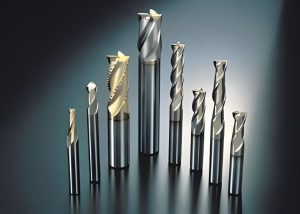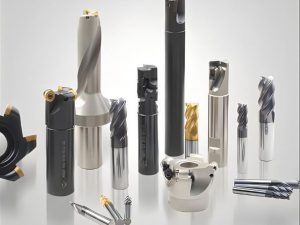Milling cutter is a rotating tool with one or more teeth used for milling, and the teeth are used to intermittently cut off the workpiece in turn. According to the purpose, material and structure of the milling cutter is divided into different types, the following is a brief introduction to the common milling cutter which.
First, there are a variety of common types of milling cutters according to the distinction of use:
① cylindrical milling cutter: for horizontal milling machine processing plane. Cutter teeth are distributed on the circumference of the milling cutter, according to the tooth shape is divided into straight teeth and spiral teeth two. According to the number of teeth into coarse teeth and fine teeth. Spiral tooth coarse tooth milling cutter teeth less, high strength, large chip space, suitable for rough machining; fine tooth milling cutter for finishing.
② Face milling cutter: used for vertical milling machine, end milling machine or, gantry milling machine, on the processing plane, end and circumference have cutter teeth, there are coarse teeth and fine teeth. Its structure has a whole type, inlaid tooth type and 3 kinds of indexable.
③ End Mills: Used for machining grooves and step surfaces, etc. The teeth are on the circumference and end face, and cannot be fed in the axial direction when working. When the end mill has end teeth through the center, it can be axially fed (usually double-edged end mills are also called; keyway milling cutters; can be axially fed).
④ Three-sided end mill: used for machining various grooves and step surfaces, with teeth on both sides and circumference.
⑤ Angle milling cutter: used for milling into a certain angle of the groove, there are two kinds of single-angle and double-angle milling cutter.
⑥ Saw blade milling cutter: used to process deep grooves and cut off the workpiece, with more teeth on its circumference. In order to reduce the friction when milling, there are sub-deflection angle on both sides of the cutter teeth. In addition, there are key slot milling cutters dovetail slot milling cutters T-slot milling cutters and various forming milling cutters.
Second, according to the structure of the milling cutter is divided:
①Integrated type: The cutter body and the cutter teeth are made into one.
②Integrated welded teeth: The teeth are made of carbide or other wear-resistant tool materials and brazed on the cutter body.
③Inlaid teeth type: The teeth are fastened to the cutter body by mechanical clamping method. This interchangeable tooth can be the head of the overall tool material, but also the head of the welded tool material. The milling cutter with the head sharpened on the tool body is called internal sharpening type; the head sharpened separately on the fixture is called external sharpening type.
This structure has been widely used in face milling cutters, end mills and three-sided milling cutters.





